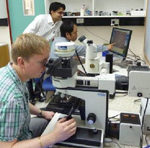

The rat flood
March 26, 2014

It is known as ‘bamboo death’ and it’s an ecological phenomenon that happens every 50 years in India, Bangladesh and Myanmar causing widespread famine and devastation. The cycle involves Melocanna baccifera – a species of bamboo which features mass flowering across a large area of forest. After flowering, the bamboo dies and regenerates from the seeds. Rats feast on these seeds, which are in abundance, and this causes a sudden boom in the rodent population. Once they’ve exhausted the supply of seed, the rats then flood into rural areas, feasting on crops and stored grain.
Bangladeshi PhD student Nikhil Chakma from University of Dhaka has been undertaking research to understand the cycle of these rodent outbreaks. With the help of the Crawford Fund, he was able to travel to Australia where he trained in rodent taxonomy and genetics at the South Australian Museum and CSIRO in Canberra. This involved careful preparation of rodent specimens so that detailed body and skull measurements could be taken and used for specific identification.

Mr Chakma gained detailed skills and knowledge in dissection, fixation, histological preparation and staining, and then interpretation of stained sections of reproductive tissues from males and females.
He returned to Bangladesh with an understanding of the drivers of reproductive activity and a range of new techniques and ideas for further research to improve rodent population management in his country.
“Without this award, it would have been extremely difficult for me to accurately identify the rodent species that I have collected during my PhD research. I am now very confident in the use of various rodent taxonomic keys and undertaking detailed morphometric measurements. This training will enable me to successfully complete my PhD research,” Mr Chakma said.




